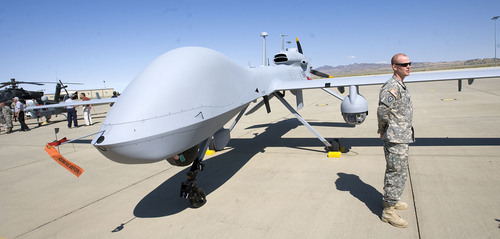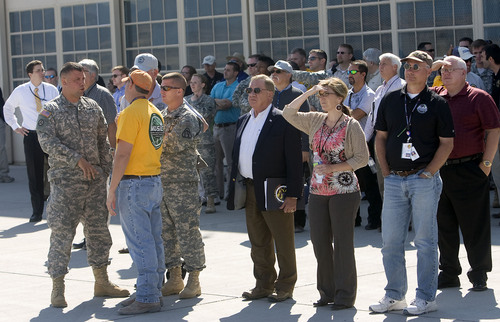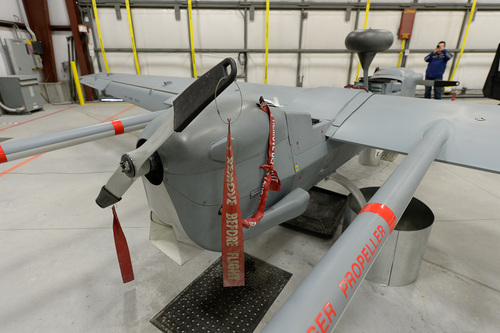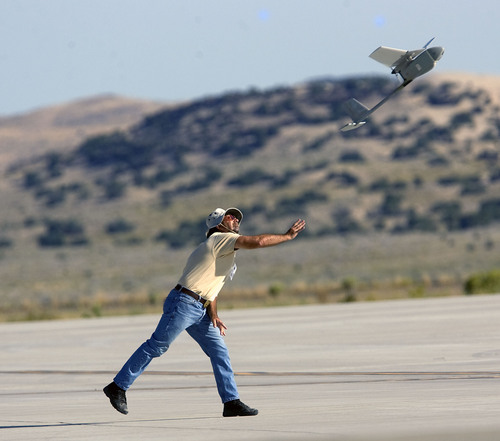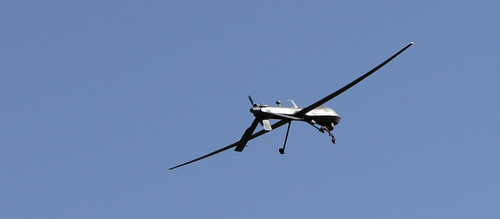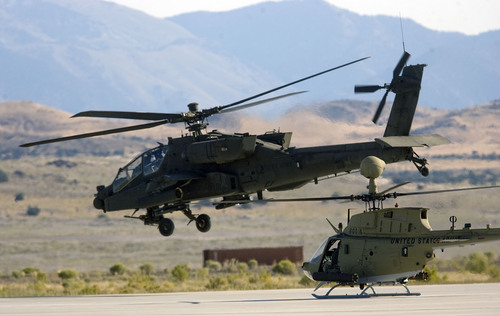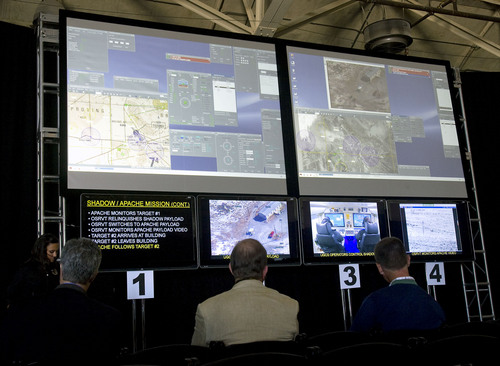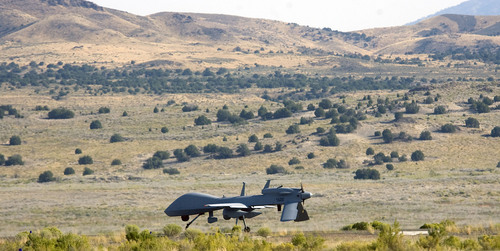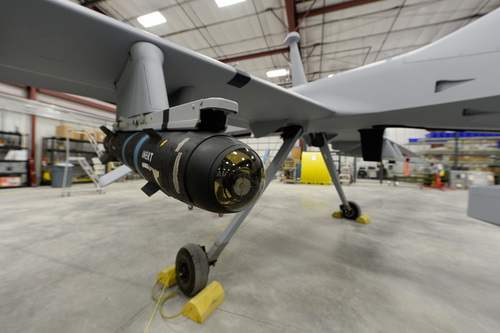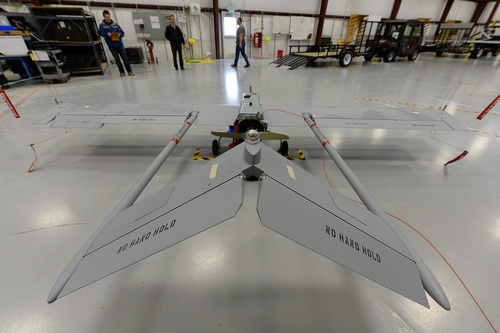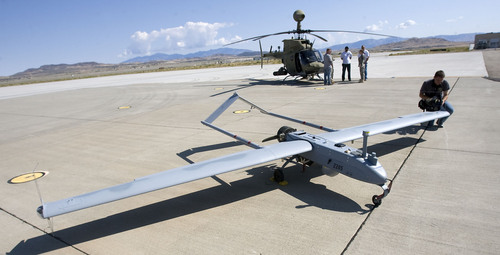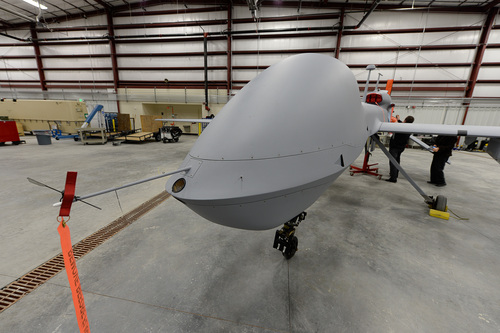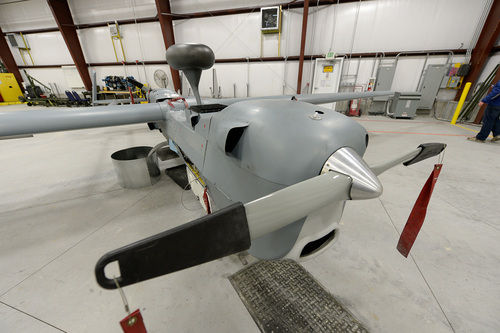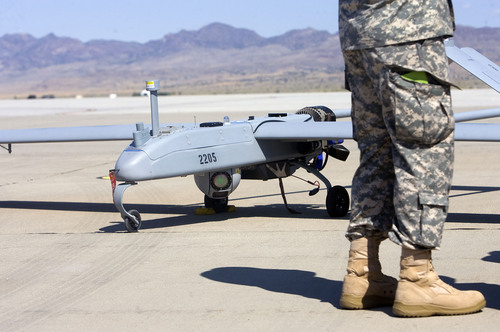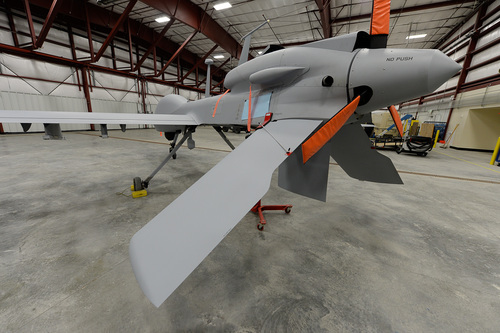This is an archived article that was published on sltrib.com in 2014, and information in the article may be outdated. It is provided only for personal research purposes and may not be reprinted.
Dugway Proving Ground • Earlier this year, Apache helicopters flying in Afghanistan received new companions in the sky.
Two types of drones — the MQ-1C Gray Eagle and the RQ-7 Shadow — began flying in tandem with the Apaches. The drones' cameras and sensors transmit the intelligence to the Apache crew — showing it what lies over the hill so the Apaches don't have to expose themselves to find a target to attack or don't fly into an ambush.
The Shadow has no armament. But if it's a Gray Eagle in the air, the Apache crew could order the drone to fire its Hellfire missiles at the target — keeping the Apache crew from harm altogether.
Before the helicopters and drones were paired in Afghanistan, they flew together in Utah.
Dugway Proving Ground is the Army's primary testing center for unmanned aircraft systems, or UAS. (Just about everyone in aviation dislikes the term "drone.") At Dugway, the Army is trying to make UAS more efficient and easier to use, planning for the day when UAS are even more ubiquitous on the battlefield.
"It's really the fabric of our Army right now,"said Col. Tim Baxter, the Army project manager for UAS. Baxter said UAS is changing the way the Army fights and points to their heavy use in Afghanistan.
The way the Army fights is what concerns a Utah law professor. He wonders if the Army should also be testing ways to avoid killing civilians, too.
—
Universal operator • The first UAS took flight at Dugway as early as 1981. In 2009, the Army announced it was building a UAS facility at Dugway, permanently adding unmanned aviation to a research portfolio that included biological and chemical weapons testing.
While the public has been debating how to regulate UAS flown by the private sector or by state and local governments, UAS at Dugway have been flying in relative obscurity. Dugway is an isolated, 798,214-acre facility with buildings and people on only a sliver of that space.
Dugway sits adjacent to the Air Force's Utah Test and Training Range — another 953,600 acres of open ground with airspace above it.
The Army has used all that space to test UAS in the air and on the ground. While UAS in the Air Force are flown from a command center thousands of miles away, the Army philosophy is to have troops in the field operate and receive UAS intelligence. The pairing of the UAS and the Apaches is one example. A UAS can also transmit images and data to mobile operating centers installed on the backs of Humvees. Other times, it means transmitting to screens platoon or company commanders are holding in their hands.
"The Army has really embraced the whole notion of pairing unmanned [and] manned systems," Baxter said.
Baxter has said the Army is not focused on creating a new model of UAS. Instead, it is trying to improve the aircraft it has through component and operating system upgrades.
In another contrast with the Air Force, most of the Army's UAS operators are enlisted men, rather than officers. Until now, the Army had to train different units to operate different UAS. Starting with the budget year that begins Oct. 1, the Army plans to start making its operating systems more universal — giving a lone soldier the ability to operate multiple types of UAS from one control station.
"The plan is not to have specification," Baxter said.
A recent report by the RAND Corp. suggests the Army may be finding value in its UAS policy. The Army favors short-range drones, and RAND said long-range UAS are difficult to operate and susceptible to anti-air defenses.
—
Right target • The RAND report also said the United States needs to address its own use of UAS and how it fits into international norms. That will help ensure other countries don't misuse drones, the report said.
University of Utah law professor Amos Guiora has argued the United States has been violating international law by going through an insufficient process for selecting targets, resulting in errant attacks that have killed civilians. He believes the Army UAS program is representative of the U.S. problem — the program focuses on how to kill targets with little discussion of whether the U.S. should.
Guiora, who was a judge advocate general in the Israeli military, argues the evaluation of intelligence and how to vet targets should be integrated into the Army's UAS development and training.
"What worries me about America's drone policy," Guiora said, "is the lack of a narrow definition of the word 'imminence,' of target of threat and of who the target is."
Baxter said avoiding the killing of innocents is a concern, but he acknowledged not much focus is placed on it at Dugway. Operators in the field and intelligence personnel are the ones focused on hitting correct targets and avoiding wrong ones.
"We build the material solutions based on the requirements given to us," Baxter said.
ncarlisle@sltrib.com Twitter: @natecarlisle


